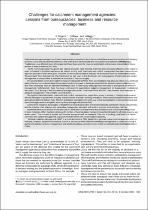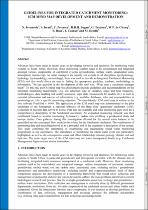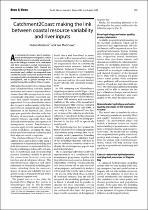JavaScript is disabled for your browser. Some features of this site may not work without it.
- ResearchSpace
- →
- Research Publications/Outputs
- →
- Journal Articles
- →
- View Item
| dc.contributor.author |
Scott, DF

|
en_US |
| dc.date.accessioned | 2007-02-06T12:09:41Z | en_US |
| dc.date.accessioned | 2007-06-07T10:07:30Z | |
| dc.date.available | 2007-02-06T12:09:41Z | en_US |
| dc.date.available | 2007-06-07T10:07:30Z | |
| dc.date.copyright | en_US | |
| dc.date.issued | 1993-10 | en_US |
| dc.identifier.citation | Scott, DF. 1993. Hydrological effects of fire in South-African mountain catchments. Journal of hydrology, vol 150, 4 February, pp 409-432 | en_US |
| dc.identifier.issn | 0022-1694 | en_US |
| dc.identifier.uri | http://hdl.handle.net/10204/1530 | en_US |
| dc.identifier.uri | http://hdl.handle.net/10204/1530 | |
| dc.description.abstract | Stream flow and its storm-flow elements in four catchments were analyzed by the paired catchment method for a response to fire. Prior to burning two of the catchments were vegetated with over-mature fynbos (the indigenous scrub vegetation of the southwestern Cape, South Africa), one was afforested with Pinus radiata and the fourth with Eucalyptus fastigata. One of the fynbos catchments was burned in a prescribed fire in the late dry season. The other catchments burned in wildfires. Neither of the fynbos catchments showed a change in storm-flow. Annual total flow increases of around 16% were in agreement with model predictions, being related to the reductions in transpiration and interception. The manner of stream flow generation appeared to have remained unaltered despite the presence of some water repellency in the soils and consequent overland flow on some steep mid slope sites. The two timber plantation catchments experienced large and significant increases in storm-flows and soil losses, while total flow increased by 12% in the pine catchment and decreased marginally in the eucalypt catchment. The pattern of the storm-flow increases was similar in both cases. After fire, storm hydrographs were higher and steeper though their duration was little changed. The respective first year increases in the pine and eucalypt catchments were 290% and 1110% for peak discharge, 201% and 92% for quick-flow volume, and 242% and 319% for storm response ratio. These fire effects are considered to be due to changes in storm-flow generation consistent with an increased delivery of overland flow (surface runoff) to the stream channel. This was caused, in part, by reduced infiltration resulting from water repellency in the soils of the burned catchments. Overall the hydrological effects of fire are related to numerous interactive factors, including the degree of soil heating, the vegetation type and soil properties. | en_US |
| dc.format.extent | 1351352 bytes | en_US |
| dc.format.mimetype | application/pdf | en_US |
| dc.language.iso | en | en_US |
| dc.publisher | Elsevier Science BV | en_US |
| dc.rights | Copyright: 1993 Elsevier Science BV | en_US |
| dc.source | en_US | |
| dc.subject | Fire-hydrological effects | en_US |
| dc.subject | Pine catchments | en_US |
| dc.subject | Fynbos catchments | en_US |
| dc.subject | Mountain catchments | en_US |
| dc.subject | Eucalypt catchments | en_US |
| dc.subject | Soil water yields | en_US |
| dc.subject | Veld fires | en_US |
| dc.subject | Controlled fires | en_US |
| dc.subject | Timber plantation catchments | en_US |
| dc.title | Hydrological effects of fire in South-African mountain catchments | en_US |
| dc.type | Article | en_US |
| dc.identifier.apacitation | Scott, D. (1993). Hydrological effects of fire in South-African mountain catchments. http://hdl.handle.net/10204/1530 | en_ZA |
| dc.identifier.chicagocitation | Scott, DF "Hydrological effects of fire in South-African mountain catchments." (1993) http://hdl.handle.net/10204/1530 | en_ZA |
| dc.identifier.vancouvercitation | Scott D. Hydrological effects of fire in South-African mountain catchments. 1993; http://hdl.handle.net/10204/1530. | en_ZA |
| dc.identifier.ris | TY - Article AU - Scott, DF AB - Stream flow and its storm-flow elements in four catchments were analyzed by the paired catchment method for a response to fire. Prior to burning two of the catchments were vegetated with over-mature fynbos (the indigenous scrub vegetation of the southwestern Cape, South Africa), one was afforested with Pinus radiata and the fourth with Eucalyptus fastigata. One of the fynbos catchments was burned in a prescribed fire in the late dry season. The other catchments burned in wildfires. Neither of the fynbos catchments showed a change in storm-flow. Annual total flow increases of around 16% were in agreement with model predictions, being related to the reductions in transpiration and interception. The manner of stream flow generation appeared to have remained unaltered despite the presence of some water repellency in the soils and consequent overland flow on some steep mid slope sites. The two timber plantation catchments experienced large and significant increases in storm-flows and soil losses, while total flow increased by 12% in the pine catchment and decreased marginally in the eucalypt catchment. The pattern of the storm-flow increases was similar in both cases. After fire, storm hydrographs were higher and steeper though their duration was little changed. The respective first year increases in the pine and eucalypt catchments were 290% and 1110% for peak discharge, 201% and 92% for quick-flow volume, and 242% and 319% for storm response ratio. These fire effects are considered to be due to changes in storm-flow generation consistent with an increased delivery of overland flow (surface runoff) to the stream channel. This was caused, in part, by reduced infiltration resulting from water repellency in the soils of the burned catchments. Overall the hydrological effects of fire are related to numerous interactive factors, including the degree of soil heating, the vegetation type and soil properties. DA - 1993-10 DB - ResearchSpace DP - CSIR KW - Fire-hydrological effects KW - Pine catchments KW - Fynbos catchments KW - Mountain catchments KW - Eucalypt catchments KW - Soil water yields KW - Veld fires KW - Controlled fires KW - Timber plantation catchments LK - https://researchspace.csir.co.za PY - 1993 SM - 0022-1694 T1 - Hydrological effects of fire in South-African mountain catchments TI - Hydrological effects of fire in South-African mountain catchments UR - http://hdl.handle.net/10204/1530 ER - | en_ZA |









